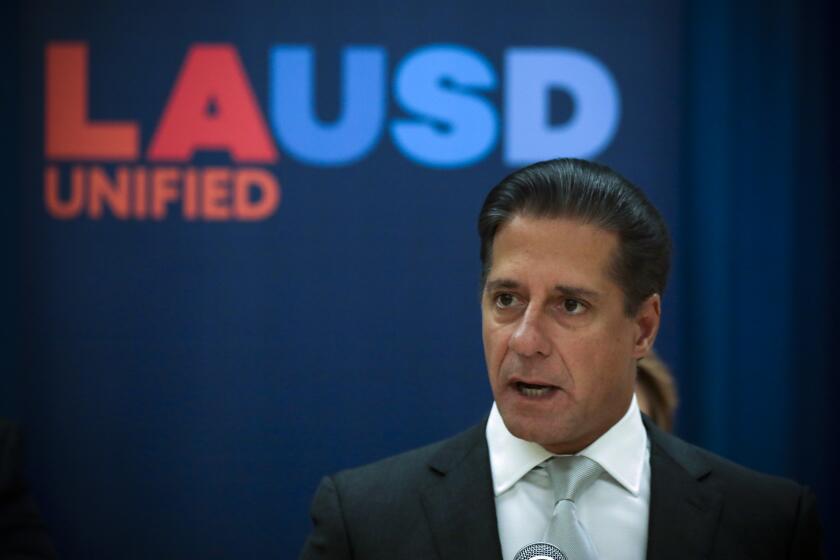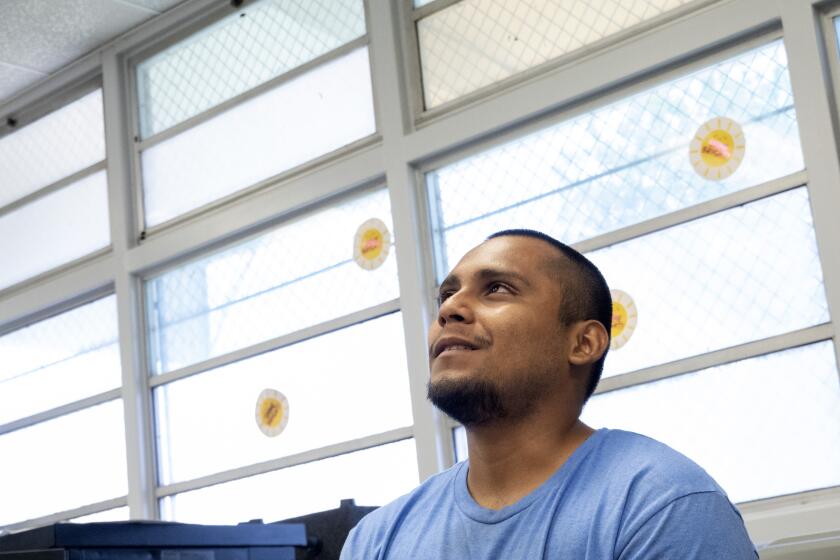How California schools are spending billions in record pandemic aid

- Share via
California school districts are largely on track to spend billions of dollars in pandemic aid before their 2024 deadline — with much of the funding targeting summer and after-school learning — but questions persist over how well the money is being spent to help students make up ground academically, researchers have concluded.
The report, released earlier this month, examines the Elementary and Secondary School Emergency Relief Act (ESSER III) — the third, last and largest tranche of federal aid that went to schools to offset the harms of the COVID-19 pandemic. This round of aid totaled $122 billion nationwide, including about $15.1 billion for California. That’s an amount equal to about 19% of what the state provides annually for its schools.
School systems had broad latitude for using the money, but there also were reporting requirements, especially in California — and these disclosures were reviewed in detail by researchers from FutureEd, a think tank at Georgetown University’s McCourt School of Public Policy.
While schools used much of their previous federal pandemic aid on health and safety and distance learning, “the hope has been that ESSER III would aid academic recovery,” the researchers wrote. “We found both encouraging trends and cause for concern.”
Across California, the biggest expenditures have gone toward academic recovery efforts, which have consumed 31% of the spending so far. Many observers want this percentage to be higher, but the figure is well above the federal requirement of 20%.
A report Wednesday provided a stark warning that academic recovery efforts nationwide have not resulted in a swift recovery.
In a national sampling of 17,400 students, math and reading scores among America’s 13-year-olds fell to their lowest levels in decades. Math scores plunged by the largest margin recorded since such testing began in the early 1970s on the National Assessment of Educational Progress, which is often referred to as the nation’s report card because it tests students in a consistent manner across the country.
California break-out data were not available for this testing cycle.
Similar setbacks were reported last year when NAEP released broader results showing the pandemic’s effects on America’s fourth- and eighth-grade students.
In hopes of turning things around, California’s 1,018 school districts serving more than 5.8 million students will have to spend or commit about $1 billion per quarter by September 2024, but the vast majority appear able to do so, even if they got off to a slow start.
By the end of March, San Francisco Unified, with about 50,000 students, had used nearly 80% of its $94 million in federal aid. Los Angeles Unified, with about 429,000 students, had spent about 37% of its $2.6 billion. Long Beach Unified School District, with about 67,000 students, had spent 5% of its $212 million. Districts serving high-poverty communities received more money per student.
Los Angeles district officials have said they are confident the district will spend or commit its funding to a contract or program by the deadline. In L.A. Unified the money has paid for 451 mental health staffers, 336 intervention teachers and aides for young students struggling in math and reading, 291 more specialists for students with disabilities, 242 custodians and 222 technical support workers for school staff and students. The district also ramped up tutoring and organized optional districtwide “acceleration days” for students, among other uses.
L.A. Unified Supt. Alberto Carvalho said the program that will replace the lauded Primary Promise is more equitable and effective, while costing far less.
Although state reporting by Long Beach reflects only $11 million in spending from the district’s $212-million allotment, the district plans to spend the money over the next year and a half as part of a six-year, $500-million improvement blueprint that draws on money from various sources, the report stated.
Long Beach made sure first to spend earlier COVID-related aid.
“I put them in order, first in, first out, by expiration,” Renee Arkus, Long Beach Unified’s executive director of fiscal services, told the researchers.
But elsewhere, notably Stockton Unified, slow spending has been characterized as both a sign of dysfunction and alleged corruption. Through March, that district had spent 2% of its ESSER III money. Separately, independent auditors have raised questions over millions of dollars of possible fraud in officials’ use of pandemic stimulus funds. District officials have denied wrongdoing.
If the money is not spent effectively, it could become a lost, one-time opportunity.
The spending analysis comes as school districts throughout California are worried about financially leaner years ahead — expecting painful cutbacks and possibly layoffs when the pandemic funding expires. Los Angeles Unified, the state’s largest district, anticipates cutting back by more than 2,000 staff positions through attrition, transfers and elimination of unfilled positions.
The school system approved an $18.8-billion budget Tuesday in what officials described as a “transition year” between having more money than could be quickly spent and a rapidly approaching future with sharply reduced resources.
Researchers noted that because pandemic aid arrived in successive waves, it’s difficult to assess how all of it was or is being spent, especially because earlier reporting requirements were more limited. For that reason, the researchers focused on the pot of money with the most detailed reporting requirements, which also was the largest and the last major distribution of federal funds.
This money began to flow in the second quarter of 2021 — well into the pandemic, which closed campuses across California in March 2020. By this point, school systems were moving away from emergency COVID protection measures and distance learning costs — or they had found other funding sources for this purpose. As a result, only about 7% of the ESSER III COVID relief has been used for COVID safety and 9% for education technology.
L.A. Unified, which spent far more on health measures than other school systems because of a groundbreaking districtwide weekly coronavirus testing effort, has pulled back on such spending. The district had earlier planned to spend $272 million of relief funding this year on coronavirus testing, contact tracing and vaccinations. Instead, the actual spending is estimated at $26 million.
Spending trends showed comparatively little money spent on mental health — a key concern raised nationwide by experts. Part of the problem has been a nationwide shortage of mental health professionals. Spending in this area has been rising — up from $24 million in the final quarter of 2021 to $105 million in the first quarter of 2023.
For academic recovery, the largest amount of funds has gone toward summer and after-school learning. Spending on tutoring rose after a slow start. Extending the school day or school year has never taken off as a primary use for this funding.
When Congress originally approved the money, it was assumed that school systems would be in such dire financial shape that a huge portion of the dollars would be needed simply to keep district budgets afloat.
Instead, in California at least, strong tax revenues propelled school funding to new highs during the last two years. Even so, about 22% of the funding spent to date has been used to “maintain operations.”
“While the federal law specifically allows such spending, the language offers little insights as to how districts are using the money,” the researchers wrote. The researchers were stymied repeatedly by such vague language in their ability to evaluate spending, although they were able to obtain more detail through contacting school officials. And many school districts, including Oakland Unified, have posted additional information online for their constituents.
The researchers gave mixed reviews to San Francisco Unified, even though the district has done well in not leaving money on the table.
By the end of March, the district had spent $74 million of its $94-million allotment. “But nearly all of that is in a broad category called ‘other activities that are necessary to maintain the operation and continuity of services ... and to continuing the employment of their existing staff,’ ” according to the report.
To the researchers, it was unclear how well San Francisco has followed through with expanded learning recovery efforts the district had originally outlined. District officials insist they are following their plan.
District critics, however, are dissatisfied.
“Instead of taking the funds and applying them where they were needed most — to address learning loss, student well-being and the serious impacts and widening equity gap we saw ... from the pandemic — San Francisco Unified chose to plug our structural budget deficit,” said Meredith Dodson, co-founder and executive director of San Francisco Parent Coalition. The district “just used them to kick the can further down the road.”
In announcing their spending plan, officials acknowledged that most of the funds “are being used to maintain core district and school operations, to stabilize student services and resources, and to retain school site and district staff.”
That strategy “was informed by community feedback that the loss of services to school sites as a result of expenditure reductions would compound the trauma and challenge faced by students throughout and because of COVID-19.”
Study co-author Phyllis Jordan noted that “this sort of spending is definitely an allowable use. But as the end of the spending window approaches, using this money to keep the lights on is going to leave districts with a lot of unsustainable spending. And that will mean cuts of all sorts after the funding expires.”
An influx of billions of dollars of state funding is aimed at addressing the crisis, but the need is urgent.
This issue also has come up in L.A. Unified. Andrew Thomas, director of the district’s Independent Analysis Unit, raised concerns at a recent Board of Education meeting.
“There are some real risks that we haven’t faced as much in the past as we’re facing now,” Thomas said. “One-time money is going away.”
The Associated Press contributed to this report.
More to Read
Sign up for Essential California
The most important California stories and recommendations in your inbox every morning.
You may occasionally receive promotional content from the Los Angeles Times.
















